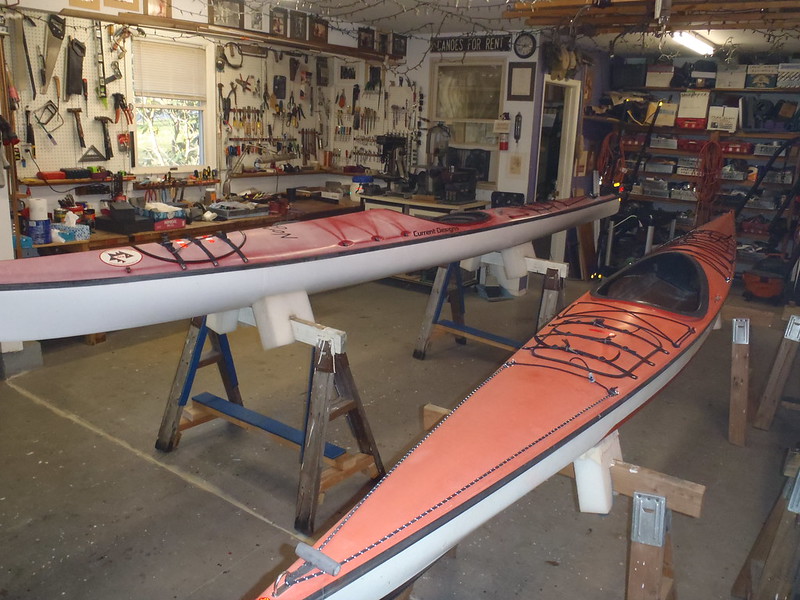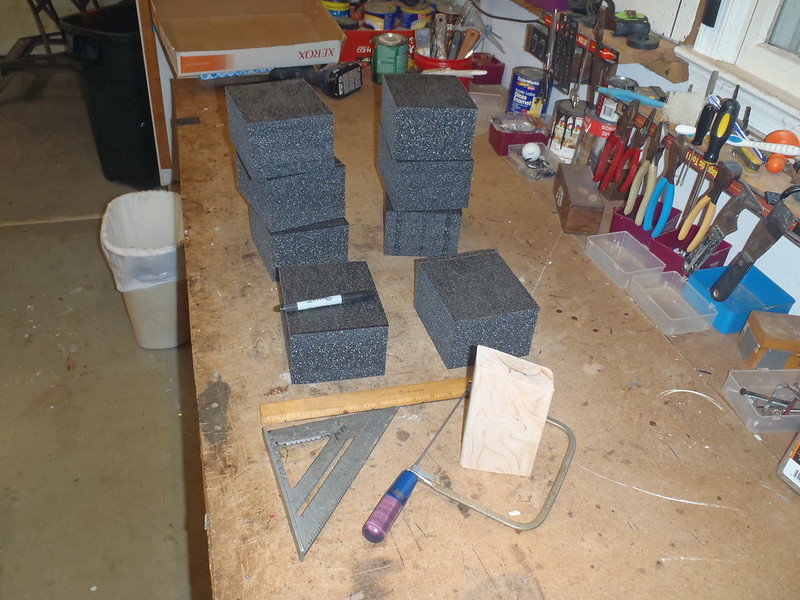- Joined
- Jul 6, 2021
- Messages
- 643
- Reaction score
- 562
The shop didn’t stay boat empty for long, I needed to bring in a couple repaired boats and get them ready for transport. Long, narrow wobbly kaya. . . .things.
 PC130004 by Mike McCrea, on Flickr
PC130004 by Mike McCrea, on Flickr
Note the angled foam block stabilizers on the sawhorses. That led to shop fun with Ethafoam blocks.
Back when I was part of the workaday world I saved ethafoam packing blocks from crates of expensive laboratory equipment . Those blocks would otherwise go in the trash, and I have uses for free easy-cut foam. Closed cell foam, but not minicel or EVA foam; ethafoam will start to UV degrade after a few years if outside exposed, but they are free, landfill destined and I have mostly indoor uses.
Cut and angle-notched those ethafoam blocks made dandy hull stabilizers for working on an upright canoe, or kayak flipped either way, and I can adjust them to fit different hull dimensions.
A paddler friend from my lab days received a shipment of -80c freezers and asked if I wanted the ethafoam blocks, “each 12.5" long c 5" wide x 3 1/2" thick”. Oh heck yes, count me in. “Each” meant happily receiving dozens of them. I was ethafoam rich again.
Ethafoam slices and dices like butter. So easily I don’t need the bandsaw, just a coping saw. And a scrap piece of 2x4 to trace an angled slot, to cut out slightly narrower than the sawhorse crossbar’s 1 ½” width so the stabilizer block has a firm grip.
Really oomphing around with repairs I cinch a cam strap around the horses to snug the hull tight to those foam blocks, but for most more gentle boat work the angled blocks alone are sufficient.
 PB110010 by Mike McCrea, on Flickr
PB110010 by Mike McCrea, on Flickr
Those ethafoam stabilizers don’t need to be huge, although taller sometimes helps to keep narrower sharp stemmed or vee bottom boat bottoms sufficiently elevated.
 PC140009 by Mike McCrea, on Flickr
PC140009 by Mike McCrea, on Flickr
For starters I cut a four of those blocks in half to make eight 6 ¼” long chunks. Traced a 2x4 outline and made the cuts a little narrower, angled at end of the fitted slot, so they would seat on the sawhorse 2x4’s tilted inwards /-/_____\-\ to capture the chine curves of a hull.
Yeah boy, those ethafoam blocks cut in half lengthwise made a two set of 4 each stabilizers in a few minutes work.
 PC140003 by Mike McCrea, on Flickr
PC140003 by Mike McCrea, on Flickr
Time to make a production run batch of slotted/angled boat horse stabilizers. I will be seeing a number of paddling friends before the year is out, and maybe I can channel my inner Oprah, “You get a set of stabilizers, and you get a set of stabilizers. . . . .”
 PC140011 by Mike McCrea, on Flickr
PC140011 by Mike McCrea, on Flickr
Plenty to go around. Stocking stuffers if the recipients have really big feet. Heck, if my friend in the Nutmeg State ever gets off his butt and fixes his boats I’ll mail him a four set.
I still have lots of those ethafoam blocks left uncut, and I have ideas. The crossbars on my folding plastic “travelling” sawhorses are wider 2x4’s, and I need to pack those travel horses for some upcoming boat deliveries and away-from-home canoe repairs. I made a custom four set with 2” wide slots for those folding plastic horses.
 PC140002 by Mike McCrea, on Flickr
PC140002 by Mike McCrea, on Flickr
 PC130004 by Mike McCrea, on Flickr
PC130004 by Mike McCrea, on FlickrNote the angled foam block stabilizers on the sawhorses. That led to shop fun with Ethafoam blocks.
Back when I was part of the workaday world I saved ethafoam packing blocks from crates of expensive laboratory equipment . Those blocks would otherwise go in the trash, and I have uses for free easy-cut foam. Closed cell foam, but not minicel or EVA foam; ethafoam will start to UV degrade after a few years if outside exposed, but they are free, landfill destined and I have mostly indoor uses.
Cut and angle-notched those ethafoam blocks made dandy hull stabilizers for working on an upright canoe, or kayak flipped either way, and I can adjust them to fit different hull dimensions.
A paddler friend from my lab days received a shipment of -80c freezers and asked if I wanted the ethafoam blocks, “each 12.5" long c 5" wide x 3 1/2" thick”. Oh heck yes, count me in. “Each” meant happily receiving dozens of them. I was ethafoam rich again.
Ethafoam slices and dices like butter. So easily I don’t need the bandsaw, just a coping saw. And a scrap piece of 2x4 to trace an angled slot, to cut out slightly narrower than the sawhorse crossbar’s 1 ½” width so the stabilizer block has a firm grip.
Really oomphing around with repairs I cinch a cam strap around the horses to snug the hull tight to those foam blocks, but for most more gentle boat work the angled blocks alone are sufficient.
 PB110010 by Mike McCrea, on Flickr
PB110010 by Mike McCrea, on FlickrThose ethafoam stabilizers don’t need to be huge, although taller sometimes helps to keep narrower sharp stemmed or vee bottom boat bottoms sufficiently elevated.
 PC140009 by Mike McCrea, on Flickr
PC140009 by Mike McCrea, on FlickrFor starters I cut a four of those blocks in half to make eight 6 ¼” long chunks. Traced a 2x4 outline and made the cuts a little narrower, angled at end of the fitted slot, so they would seat on the sawhorse 2x4’s tilted inwards /-/_____\-\ to capture the chine curves of a hull.
Yeah boy, those ethafoam blocks cut in half lengthwise made a two set of 4 each stabilizers in a few minutes work.
 PC140003 by Mike McCrea, on Flickr
PC140003 by Mike McCrea, on FlickrTime to make a production run batch of slotted/angled boat horse stabilizers. I will be seeing a number of paddling friends before the year is out, and maybe I can channel my inner Oprah, “You get a set of stabilizers, and you get a set of stabilizers. . . . .”
 PC140011 by Mike McCrea, on Flickr
PC140011 by Mike McCrea, on FlickrPlenty to go around. Stocking stuffers if the recipients have really big feet. Heck, if my friend in the Nutmeg State ever gets off his butt and fixes his boats I’ll mail him a four set.
I still have lots of those ethafoam blocks left uncut, and I have ideas. The crossbars on my folding plastic “travelling” sawhorses are wider 2x4’s, and I need to pack those travel horses for some upcoming boat deliveries and away-from-home canoe repairs. I made a custom four set with 2” wide slots for those folding plastic horses.
 PC140002 by Mike McCrea, on Flickr
PC140002 by Mike McCrea, on Flickr







